BOURGIE HALL CONCERTS
music reviews by

NANCY SNIPPER
2015
COUPERIN
AND CAMPRA CREATE A LOVELY COMBINATION
Arion
did it again. Always surprises within the beautiful program
this outstanding baroque orchestra offers. On Sunday, May 17th
inside Bourgie Hall, listeners were given a treat of inspiring
music – François Couperin’s La Françoise
and Andre Campra’s Messe de requiem. This celestial work
of choral music featured the professional singers of La Chapelle
de Québec. This beautiful choir was directed by award-winning
conductor/harpsichordist, Christophe Rousset. He has garnered
the most prestigious recognition: Chevalier of the Légion
d’honneur, Commander in the Ordre des Arts et des Lettres
and more.
Featured
soloists, baritone David Roth was stunning in delivering “Kyrie”
segment of the work, and was joined by tenor, Philippe Gagné.
Their voices shine.
The entire Messe was so uplifting and sublime; the religious
theme of the music was passionately conveyed.
It
was preceded by the orchestra’s La Francoise
which despite some tuning problems, and a few out-of-synch moments,
I have to say all was forgotten when Claire Guimond and Alexa
Raine Wright had their glorious moment with their baroque flutes
in a small solo solo section; it was perfect. The entire work
seemed to have the melody of beauty and lightness swirling in
and out of each phrase. It was really lovely.
So
much to savour in the concert. The joyous feelings that the
French dance suite of “ La Franéoise” invokes
is rare, but always assured when Arion is holding its baroque
instruments as their bows transports us into the beauty of both
these 17th-century compositions.
WONDERFUL
CONDUCTOR POURS PASSION INTO I MUSICI CONCERT
It’s
not every conductor that can navigate an all-string orchestra
into the multi-layered music of Richard Strauss and Franz Schubert
in one evening. However, under the brilliant baton Jean-Marie
Zeitouni (of Egyptian and French Canadian heritage), one can
expect glorious and energetic leadership. Strauss’s non-stop
complex work, Metamorphosen demands such experienced
artists of great stamina and sophistication to interpret the
pathos and yearning in this expressive compostion that last
almost a half hour.
Albeit,
trying to catch a singular melody is next to impossible as each
phrase never seems to piggy-back on to the next one and then
the next one without ever having some satisfying musical conclusion.
Key modulations imbedded in lush rich lines of polyphonic complexity
take us on an ebb and flow ride where climaxes swiftly descend
into a new musical moment.
Admittedly,
Strauss eludes me though moving segments were noted. This is
not the case though for Mr. Zeitouni who has traveled the world
conducting countless notable orchestras. He also is the director
of the Colorado Music Festival.
I loved his movements and finesse -– total dedication
to the musicians which for this work needed three double bass
players and five violists. Ten violinists sat in a semi-circle
on chairs around their conductor. Mr. Zeitouni never missed
a moment to accelerate the passion in both pieces – which
takes me to the indescribably beautiful work of Schubert’s
String Quintet in C major, Op. 163.
I felt
like I was reaching up to the heavens and touching the silver
gossamer-like filaments of an angel in the godly Adagio movement.
In contrast, the robust third movement reminded me of Beethoven.
Its ebullient melodic motif and exciting, strident rhythm seemed
to capture an Austrian peasant dance. The dynamics and profound
expression in the work was impeccably performed by I Musici’s
sixteen musicians. Mr. Zeitouni brought an inspiring and formidable
presence to every musical moment in the evening’s concert
which tool place May 13th in Bourgie Hall, Montreal.
BROTT AND BOUCHKOV BRING PASSION TO CONCERT

The brilliant internationally renowned conductor of the McGill Chamber Orchestra and multiple winner of First Prize Violinist, Marc Bouchkov performed with thrilling gusto on May 3rd in a program featuring composers, Louis Babin, Mendelssohn, Hayden and Tchaikovsky. Utterly inspiring; the performance beautifully showcased the passion and connection Mr. Brott has with all the members of his orchestra along with Mr. Bouchkov who often turned sideways to face his fellow performers. The romanticism of 24-year-old Marc Bouchkov is unmistakable. What a dashing talent he is.
So many musical themes and moods were embedded in Babin’s La Suite du Promeneur. It captured the angst and beauty we all feel as we go through life. The music offered a breezy opening of sweet converging melody lines, only to be followed by a variety of tempo and compositional flavours, including a macabre waltz and modern twists – not surprising - Babin was born in 1957. There were at least a dozen segments to the entire piece which made for a fulfilling listening experience..
 Mendelssohn’s Violin Concerto in D minor gave us the star, Marc Bouchkov. He is such a feeling performer – so expressive, that even when he was not playing, his face would react to the music. I was so enthralled with his delivery; it was as if the violin was directly connected to the emotions lifting out of his heart. He wowed us and gave us a Bach as an extra treat without the orchestra accompanying him. He was able to actually make his violin sound like it had another playing the pulsating repetitive note that persisted throughout the entire moving piece while double stringing melody played over it. What technique – what a feat..
Mendelssohn’s Violin Concerto in D minor gave us the star, Marc Bouchkov. He is such a feeling performer – so expressive, that even when he was not playing, his face would react to the music. I was so enthralled with his delivery; it was as if the violin was directly connected to the emotions lifting out of his heart. He wowed us and gave us a Bach as an extra treat without the orchestra accompanying him. He was able to actually make his violin sound like it had another playing the pulsating repetitive note that persisted throughout the entire moving piece while double stringing melody played over it. What technique – what a feat..
He performed another solo piece later in the concert that he had written in Edmonton. Entitled
Fantasie, it was a remarkable composition with several variations on a turbulent theme that showed of his Eastern European brilliance (his parents were violinists from Ukraine). His performance ranked him as a modern-day Paganini. The orchestra’s performance of Tchaikovsky’s
Serenade for Strings in C major, Op. 48 was marvelous, thus making the entire evening a rare experience for any classical music connoisseur.
GLUZMAN GLORIOUSLY PERFORMS OUTSTANDING PROGRAM WITH I MUSICI
April 8, Bourgie Hall
Guest violinist and conductor Vadim Gluzman wowed the audience with his effortless playing on his 1690 ‘ex-Leopold Auer violin while integrating I Musici’s 15 members in bringing to life the music of Mozart, Schittke and Shostakovich. It was a joyous evening of music making. Indeed, this Russian-born Israeli artist saturated each piece he performed with exuberant musicality, finesse and humour – as heard in the opening piece,
Suite in the Old Style, by Alfred Schnittke. It was a lovely
'faux baroque' composition that exemplified the genius of this 20-th-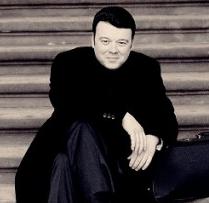 century composer. His works have garnered the highest praise in the last two decades. In
"Ballet," the second movement of the Suite, the most tender of theme
– a simple phrase line - brought tears to my eyes, and then
suddenly, Mr. Gluzman made his violin emulate some kind of cat
scratching sound. It disarmed us all, but made us laugh. It was
part of the score. Such is the unpredictability of Schnittke.
The word featured pauses, juxtaposed with dashing playfulness in
tempi that offered rhythmic excitement. Deliciously melodic lines
featured harmonics that were well applied to extracts of the two
film scores we heard that were written by Schnittke in 1960 –
using the beautiful baroque style Suite in the Old Style immediately demonstrated the relaxed manner of Mr. Gluzman’s playing and the confidence he inspired with the orchestra – considering he conducted with his back to them, and had only two days to rehearse with them.
century composer. His works have garnered the highest praise in the last two decades. In
"Ballet," the second movement of the Suite, the most tender of theme
– a simple phrase line - brought tears to my eyes, and then
suddenly, Mr. Gluzman made his violin emulate some kind of cat
scratching sound. It disarmed us all, but made us laugh. It was
part of the score. Such is the unpredictability of Schnittke.
The word featured pauses, juxtaposed with dashing playfulness in
tempi that offered rhythmic excitement. Deliciously melodic lines
featured harmonics that were well applied to extracts of the two
film scores we heard that were written by Schnittke in 1960 –
using the beautiful baroque style Suite in the Old Style immediately demonstrated the relaxed manner of Mr. Gluzman’s playing and the confidence he inspired with the orchestra – considering he conducted with his back to them, and had only two days to rehearse with them.
The
short but mighty morose work, by Mozart – Adagio and
Fugue in C minor, completely changed the spritely mood
of the opening piece. More like Beethoven and Bruckner, this
deeply complex work with its dualistic theme in fugal structure
showed us an imperious, even furious side to Mozart who never
constricted himself to the tried and true. If ever one wanted
to make a case that it was Mozart, and not Beethoven who suffered
from bi-polar disorder, this work strongly supports such a thesis.
For this part of the performance, Mr. Gluzman sat beside first
violinist/ concertmaster, Julie Triquet.
The Mozart we all love came to life in his Violin Concerto
No.3 in G major – brightly performed and with great
alacrity. Timing and expressive innuendoes were never lost to
the speed and multiple notes saturating this inestimably appealing
composition. The three movments ended all too swiftly.
The final work, Chamber Symphony Op. 110a by Shostakovich
was deeply moving in its austere and relentless raging power
and force. The fiercely ominous sounds, the repetitive sweeping
strokes and staccatos in the music reminded us of the gunfire
that robs mankind of all dignity. Played to perfection, Mr.
Gluzman dramatically craved out images of horror in the battle
terrain of Fascism, evoking images of war – all of it
astoundingly well expressed with his fellow I Musici musicians
sounding the cry of injustice.
I can’t rave enough about how stunningly enjoyable the
concert was, despite the gravity of the theme in the final piece.
The encore produced a darling happy polka by Shostakovich, and
we all left the Hall in an upbeat mood -- ready to kick up our
heels. http://imusici.com
_________________________
2014
L'ORCHESTRE DE CHAMBRE DE MONTRÉAL
HAPPY
40TH ANNIVERSARY!
It was
one of the greatest evenings of classical music to light up Bourgie
Hall -- a celebration that included musical gifts from four of
the world's best artists. The magnificent, mid-size L’Orchestre
de Chambre de Montreal led by its founder and conductor--–
the wondrously warm and gifted Wanda Kaluzny -- performed with
four invited international soloists. Each one merited a concert
on his/her own. They included top pianist, Sara Davis Buechner,
dazzling soprano, Gianna Corbisiero, terrifically versatile trumpet
player, Jens Lindemann and the brilliant 21-year-old Japanese
violinist, Fumiaki Miura.
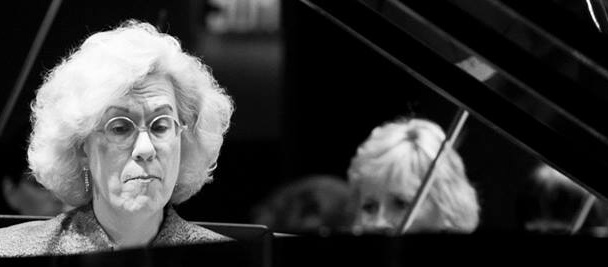 The
program opened with Ms. Buechner playing Mozart’s Concerto
No. 21 in C Major, known as “Elvira Madigan.”
She displayed impressive power and finger dexterity in Mozart’s
remarkably rapid runs, and each passage always ended as if it
was as important as the notes that opened it. I imagine she is
a marvellous performer of Beethoven and Liszt -- such is the technical
yet playful prowess of her playing. I felt the second movement
-- the Andante -- could have been more expressive with deeper
nuanced diminuendos to convey tenderness and pathos, so this part
of her performance lacked some sensitivity. Still, Ms. Buechner’s
strength brings Mozart to a new level where lots of cadenzas are
no longer connectors to fill in or end a passage but rather they
become fascinating musical statements that also show off her stunning
virtuosity. In fact, the program mentions she created these cadenzas.
Awards have been bestowed upon her from five European royals,
including Reine Elisabeth of Belgium. Ms. Buechner is one the
world’s leading keyboard artists of our time. She has garnered
top accolades for her recordings the world over (full and front
page newspaper coverage, including the Sunday Arts & Leisure
section, The New York Times). The
last time she performed with the orchestra was 11 years ago; it
was a thrilling reunion.
The
program opened with Ms. Buechner playing Mozart’s Concerto
No. 21 in C Major, known as “Elvira Madigan.”
She displayed impressive power and finger dexterity in Mozart’s
remarkably rapid runs, and each passage always ended as if it
was as important as the notes that opened it. I imagine she is
a marvellous performer of Beethoven and Liszt -- such is the technical
yet playful prowess of her playing. I felt the second movement
-- the Andante -- could have been more expressive with deeper
nuanced diminuendos to convey tenderness and pathos, so this part
of her performance lacked some sensitivity. Still, Ms. Buechner’s
strength brings Mozart to a new level where lots of cadenzas are
no longer connectors to fill in or end a passage but rather they
become fascinating musical statements that also show off her stunning
virtuosity. In fact, the program mentions she created these cadenzas.
Awards have been bestowed upon her from five European royals,
including Reine Elisabeth of Belgium. Ms. Buechner is one the
world’s leading keyboard artists of our time. She has garnered
top accolades for her recordings the world over (full and front
page newspaper coverage, including the Sunday Arts & Leisure
section, The New York Times). The
last time she performed with the orchestra was 11 years ago; it
was a thrilling reunion.
Next
on the remarkable rostrum was soprano, Gianna Corbisiero. Wow!
Wow! Wow! Her lusciously rich voice sent us to heaven and her
cute gestures and facial expressions suited to the arias she performed
enhanced her spectacular delivery. The aria,“Ebben? Ne andrò
lontana” from Catalani’s opera, La Wally
showed her passion, restraint and control, as did her charming
“Una voce poco fa” from Il Barbiere di Siviglia.
Poise and Spanish gusto came across in her Carmen. She
showed her spicy side. In all she performed six of them, and never
did she wane in passion. Her alluring radiant stage presence dominated
each song despite the supremely demanding technical vocal feats
which she polished off with personality, vigour and sparkling
beauty.
In 1992
she performed with the orchestra, so her exhilarating presence
was all the more intense. So happy was she to bring her gifts
once more to Ms. Kaluzny’s perfect orchestra.
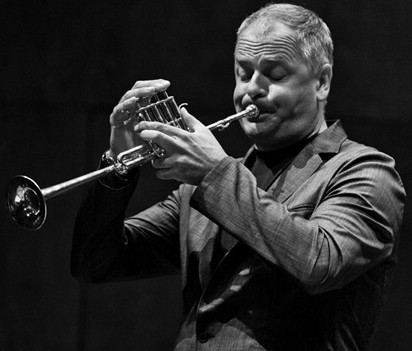 When
trumpet master Jens Lindemann hit the stage with his jokes about
his instrument really being the star of all the melodies in the
pieces he performed -- with the strings being less important --
we all laughed. Furthermore, his wit and the funny put-on theatrically
bossy persona he used to josh with his translator, MCO trumpet
player Stéphane Beaulac -- who stood beside him when called
to do so, acting like a lackey -- this was hilarious. Can this
guy Jens Lindemann ever play. He told us wonderful true stories
behind trumpet compositions, including Paul McCartney’s
trumpet stand-out segment in The Beatles’ “Penny Lane.”
His pieces came from the compositions of Debussy, Bach, Duke Ellington
and many more exceptionally stunning works representing styles
from the Baroque all the way to modern times. Four trumpets were
used in the performance; he’ll do anything to get the right
sound and the right laugh. Even the end of a toilet plunger found
its way onto the bottom of his shiny green trumpet. He used it
as a mute to make special effects as he created incredible sounds
when playing a piece from Duke Ellington. Of course the orchestra
joined him all the time.
When
trumpet master Jens Lindemann hit the stage with his jokes about
his instrument really being the star of all the melodies in the
pieces he performed -- with the strings being less important --
we all laughed. Furthermore, his wit and the funny put-on theatrically
bossy persona he used to josh with his translator, MCO trumpet
player Stéphane Beaulac -- who stood beside him when called
to do so, acting like a lackey -- this was hilarious. Can this
guy Jens Lindemann ever play. He told us wonderful true stories
behind trumpet compositions, including Paul McCartney’s
trumpet stand-out segment in The Beatles’ “Penny Lane.”
His pieces came from the compositions of Debussy, Bach, Duke Ellington
and many more exceptionally stunning works representing styles
from the Baroque all the way to modern times. Four trumpets were
used in the performance; he’ll do anything to get the right
sound and the right laugh. Even the end of a toilet plunger found
its way onto the bottom of his shiny green trumpet. He used it
as a mute to make special effects as he created incredible sounds
when playing a piece from Duke Ellington. Of course the orchestra
joined him all the time.
After
the concert during cocktails and champagne, Mr. Lindemann told
me that too many musicians take it all too seriously. Indeed,
he offers laugh-out-loud comedic relief. No wonder he was recently
named, International Brass personality of the Year – just
another award he can put amidst his other prizes, such as the
24k gold-plated trumpets that he performs on. In 1992, MCO invited
him as soloist on their California tour. 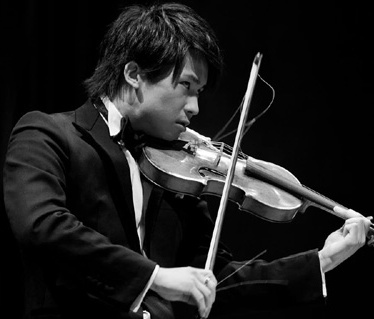
Finally,
the evening ended on a serious. Mendelssohn’s Concerto
for Violin in E Minor, Opus 64, was magnificently interpreted.
Mr. Miura is the consummate, non-showy artist whose attention
is totally on the music. His expressive playing illustrated staggeringly
supreme technique. He is an artist of such brilliance, I marvelled
at his talent and obvious hard work, for this piece is of such
difficulty, it belongs to the performance repertoire of virtuoso
violinists. He has performed in Europe and Japan and has reaped
the most prestigious awards ever bestowed on such a young musician.
I refer specifically to the Music Critic’s Prize and the
Audience Prize along with the First Prize (2009) Hannover Violin
Competition – the youngest winner in the history of the
competition and the one with the most prizes.
How
nice for Ms. Kaluzny to be gifted a huge painting of her conducting
with some of the string players in partial view. It was unveiled
at the beginning of the evening by the painter, Daniel Gautier.
The seascape in the background somehow summed up the eternal beauty
of this MCO anniversary concert. Congratulations.
Photos
© Hugo
Lorini
APPASSIONATA
CONCERT -- A MAGNIFICENT MUSICAL MATCH
What
an astounding concert Appassionata performed to close their
highly successful season. It was divine in all matters of speaking;
even the saints displayed on Bourgie Hall’s stained glass
windows seemed to applaud after each of the three works performed.
The program was definitively pleasing. I cannot rave enough
about the flawless interpretation and impeccable synchronization
of all orchestra sections led by one of Canada’s most
engaging conductor’s, Daniel Myssyk.
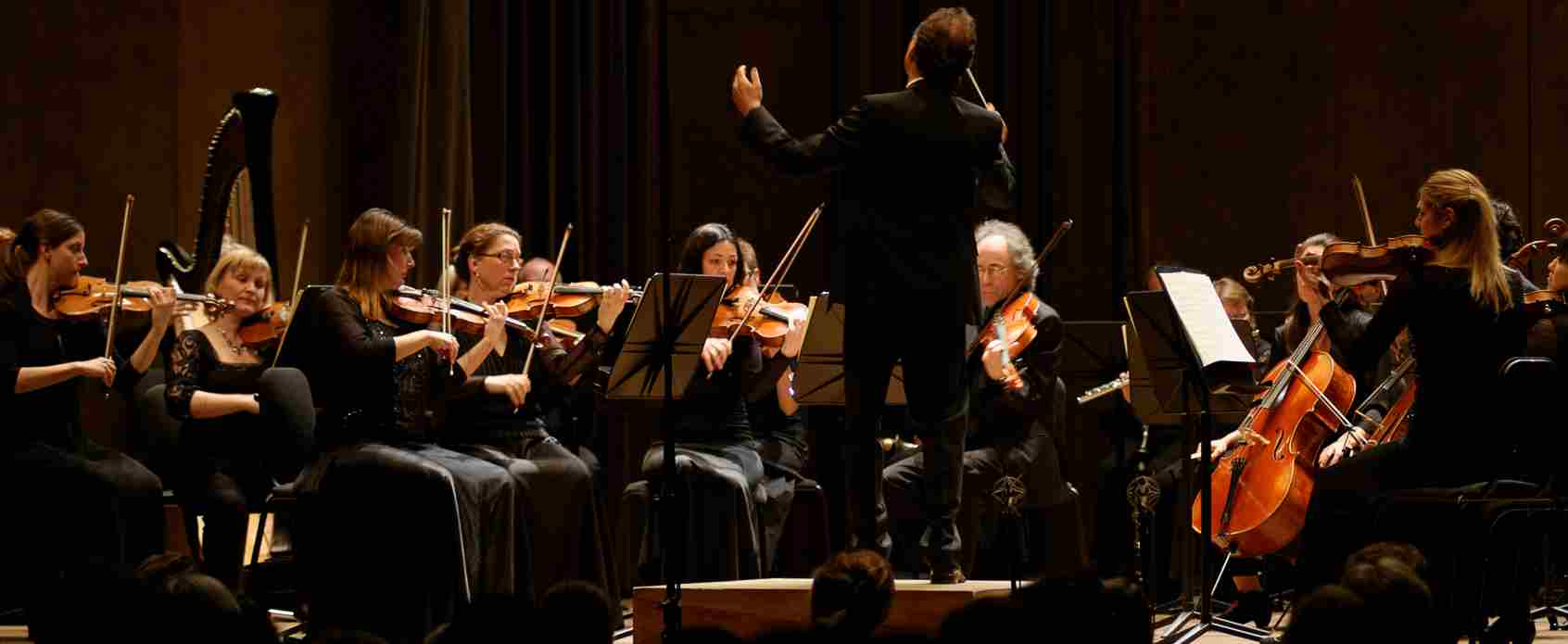
THE RAPTURE
OF RAVEL
The evening
began with Ravel’s Le Tombeau de Couperin. From
the moment the solo oboe gently opened up the first movement with
its undulating melody, we knew great music was about to be performed.
The music woke up my imagination. This rich beautiful work set
the scene. I could hear the rustling of leaves or was I seeing
the ripples in a lake?
The
second movement in 6/8 timing seemed to emulate a waltz whose
eventual macabre tones created wandering passages of contrast.
The third movement offered a vitality and exuberance of brazen
joy. I recalled my delight in this work of the harp and string
plucking that added an ethereal quality to the work. Written as
a memorial tribute to the painful memories of war, nevertheless,
the work was not sorrowful. To Ravel’s contemporaries who
remarked on the surprisingly upbeat quality in this funerary composition
– to which the title alludes, the celebrated composer replied:
“The dead are already sad enough in their eternal silence.”
I was in heaven with Appassionata’s performance of this
work which was originally conceived as a six-movement suite for
piano which the composer then orchestrated into four movements.
A PERFORMANCE
OF PIANISTIC SENSITIVITY
Internationally
acclaimed pianist, David Jalbert was the guest artist for the
evening. His performance of Mozart’s Concerto for Piano
No. 23 in A Major was warm and wondrous. The Allegro was
lively, 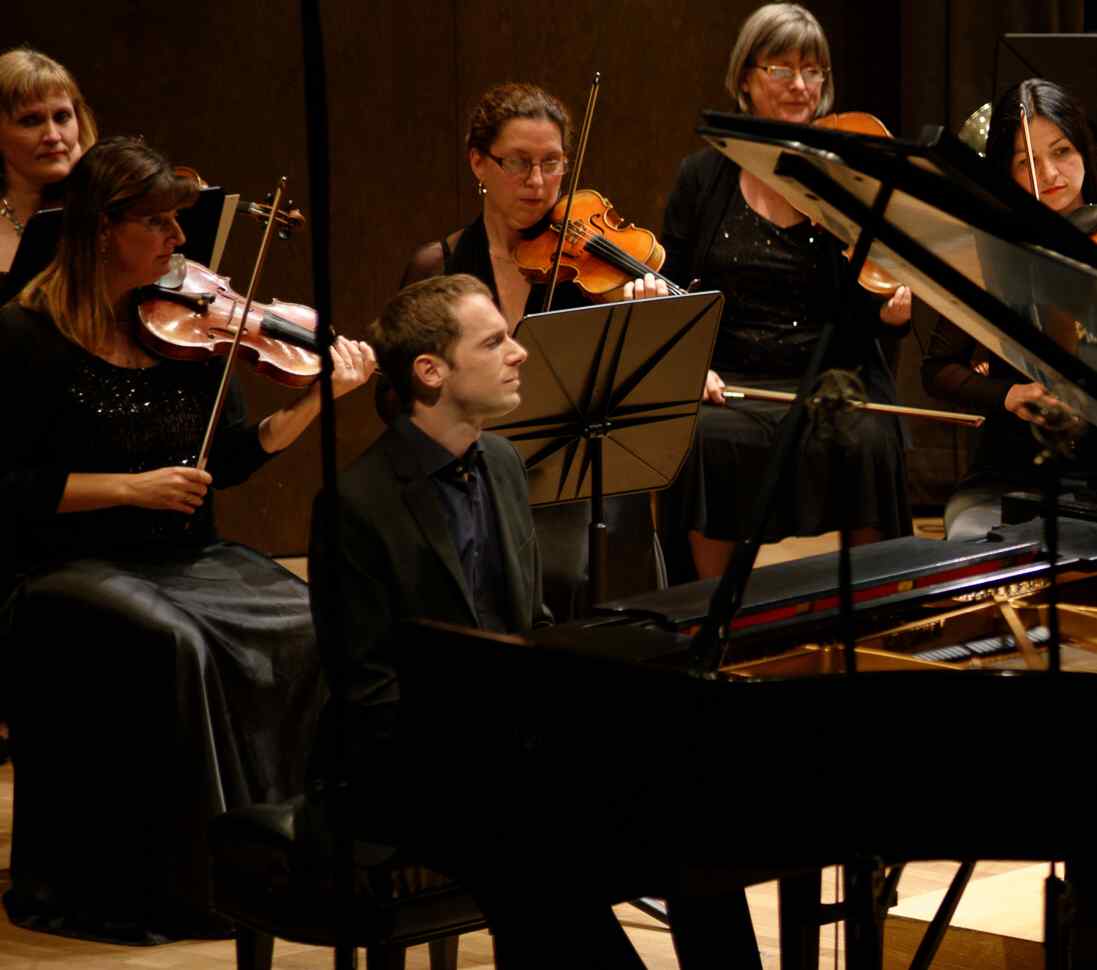 the
Adagio most tender and the Allegro Assai was full of playful spiritedness.
Mr. Jalbert’s trills and chromatic runs were silky textured.
Moreover, the clarity he obtained when dashing off such challenging
passages illustrated his brilliant virtuoso playing. Indeed, the
entire piece rarely let up in rapid complex ascensions and descents.
He is a sensitive artist who does have a touch of the nerves (as
seen in his finger shaking -- not at all audible, as it did not
affect his playing). Cleary, his genius and discipline mastered
any performance anxiety. I very much felt connected to his playing
which highlighted his attention to expressive phrasing which was
never sacrificed or rushed, despite the extreme difficulty of
this piece.
the
Adagio most tender and the Allegro Assai was full of playful spiritedness.
Mr. Jalbert’s trills and chromatic runs were silky textured.
Moreover, the clarity he obtained when dashing off such challenging
passages illustrated his brilliant virtuoso playing. Indeed, the
entire piece rarely let up in rapid complex ascensions and descents.
He is a sensitive artist who does have a touch of the nerves (as
seen in his finger shaking -- not at all audible, as it did not
affect his playing). Cleary, his genius and discipline mastered
any performance anxiety. I very much felt connected to his playing
which highlighted his attention to expressive phrasing which was
never sacrificed or rushed, despite the extreme difficulty of
this piece.
THE FIERCENESS
OF BEETHOVEN
Finally,
Beethoven’s Symphony No. 2 op. 36 in D Major was
a tour de force that once again displayed the orchestra’s
supreme confidence. Harmonious cohesion and seamless blending
of the string, wind and horn sections created climactic crescendos
of high emotional intensity.
Truly, one need not think that only a huge orchestra is capable
of creating classical music magnificence. Simply sign up for Appassionata’s
season tickets and be transported into bliss. For the upcoming
concert season, visit: www.appassionata.ca
2013
The
Foundation Arte Musica is presenting a series of outstanding
concerts within the magnificent Bourgie Hall. The collaboration
of it founder, Pierre Bourgie, and the general and artistic
director of the Arte Foundation, Isolde Lagacé, has created
a remarkable gift of music, art, film and lectures to inspire
all lovers of beauty. In fact, the program reflects the various
exhibitions housed in the Museum itself. From Debussy and French
music to Latin America with a focus on Peru and Brazil, the
music creates a glorious echo of the visual side of art that
is on display at the museum. The reviews, beginning with the
most recent, are below.
L’ORCHESTRE
DE CHAMBRE DE MONTRÉAL
Conductor
Wanda Kaluzny and cellist Cicely Parnas . . . Les femmes fatales
offering magnificent music
What a wonderful concert given by this sensational small-sized
Montreal Orchestra on Tuesday, December 10th. It was the second
in a series of ‘Discovery’ concerts celebrating the
orchestra’s 40th anniversary year – a musical body
dedicated to showcasing brilliant young talent.
Montreal-born
Maestra Kaluzny’s warmth along with her refreshingly effortless
communication between the audience and the musicians are rare
and unpretentious. She is a totally committed conductor whose
ease belies the assiduous detail she applies as she shapes the
music with her orchestra. Her foil was the incredible American
cellist Cicely Parnas. Her passion coiled in an intensely emotional
delivery of the pieces she performed was positively riveting.
Imagine these two great artists: Ms. Kaluzny who has proven all
over the world that women, baton in hand, stand professionally
and proudly as leaders on the musical podium – she has not
garnered several prestigious awards for nothing – the last
of which was the Queen Elizabeth II Diamond Jubilee Medal; and
Ms. Parnas, who at the age of 20 is major force for inspirational
technique and interpretation. She is able to reach notes as high
as one might hear in a violin, creating inestimable expressive
splendour. The effect is breathtaking as she gives all she’s
got to her 1712 Giovanni Gracino cello. Her last name is most
apt, for when you think of Mount Parnas (different spelling),
one wonders if she is a not in fact a recent addition to the pantheon
of Gods who in a sporadic act of kindness have offered her up
to us humans as if to say to the world, “This is the music
we Gods make.”
The program
opened with Beethoven’s Symphony No. 2 in D Major,
and it was really wonderful to hear it as it is rarely played.
It was followed by Cello Concerto No. 1 in A Minor by
Saint-Saëns – a masterpiece that showcased Parnas’
staggering musicality.
Tim
McGrath’s Concertino for Cello was premiered during
this concert. It was especially written for the orchestra and
Ms. Parnas, but it was his wife Anita who inspired the 18-minute-long
work. He gorgeous creations weaves all kinds of musical flavours
that reminded me of Copeland, Prokofiev and Bernstein at various
times. It was like movie music and yet it was dashingly deep.
Mr. McGrath is a Toronto composer whose credits include Degrssi
for which he won a Gemini Award for best original score for a
dramatic series.
I was
enchanted by this piece as I was by the final offering: Petit
Adagio from The Season: Autumn, by Alexander Glazunov.
It is romantically beautiful, but its short length left a kind
of comma to the evening’s end.
A word
to add: Ms. Kaluzny, in her open way did not stop the audience
from clapping in between every movement of each piece performed.
I found it somewhat puzzling that people would do this, and I
do not think it was consequent to overwhelming enthusiasm; there
was no encore, and many seats were not filled for the performance
– another source of puzzlement as this orchestra deserves
utmost attention and attendance.
Beautiful
Concerts Echo the World in Bourgie Hall
The Foundation
Arte Musica is presenting a series of outstanding concerts within
the magnificent Bourgie Hall. The collaboration of it founder
Pierre Bourgie and The Montreal Museum Fine Arts’ General
and Artistic Director, Isolde Lagacé, has created a remarkable
gift of music, art, film and lectures to inspire all lovers of
beauty. In fact, the program reflects the various exhibitions
housed in the Museum itself. From Debussy and French music to
Latin America with a focus on Peru and Brazil, the music creates
a glorious echo of the visual side of art to behold displayed
at the museum.
I had
the pleasure to attend some of these concerts – the first
of which featured musicians from the Orchestre Métropolitain:
violinists Yukari Cousineau and Marcelle Mallette, violists Brian
Bacon and Pierre Tourville, cellist Vincent Bernard and pianist
Jean Saulnier.
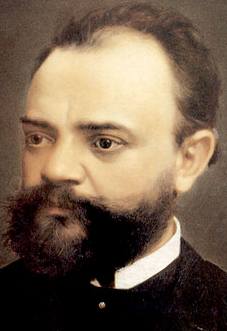 The
first part of the program featured a wondrous work by Antonin
Dvorák (1841-1904): the String Quintet in E-flat Major,
Opus 97, B. 190. Its four movements evoked vivid images of forest
magic. I felt as if I were walking in a nature nook where the
wind was whispering among leaves over my head and an enchanting
babbling brook was at my feet. The masterful variations of string
bowing created these images within a melody mimicking the airy
beauty of fluttering winged birds darting in and out of trees.
The gentle musical line ripe with rises and falls from the violas
seemed to replicate rippling waters. Great timing and mature energy
infused the playing.
The
first part of the program featured a wondrous work by Antonin
Dvorák (1841-1904): the String Quintet in E-flat Major,
Opus 97, B. 190. Its four movements evoked vivid images of forest
magic. I felt as if I were walking in a nature nook where the
wind was whispering among leaves over my head and an enchanting
babbling brook was at my feet. The masterful variations of string
bowing created these images within a melody mimicking the airy
beauty of fluttering winged birds darting in and out of trees.
The gentle musical line ripe with rises and falls from the violas
seemed to replicate rippling waters. Great timing and mature energy
infused the playing.
Indeed
such highly expressive renderings showcased the impeccable ensemble
playing of these five musicians. The third movement’s Larghetto
seemed to take a pensive turn into nostalgia and sadness. It was
as if this person I had imagined was actually reminiscing about
the days gone by when he or she could enjoy all this freedom in
nature. Was this the secret spot for a now older person who was
reflecting back on childhood? Clearly Dvorák was inspired
by his land. This was not music made to impress aristocrats; this
was music for people living in and in love with the rustic surroundings
characterizing their country’s countryside. There were suggestions
of peasant robustness -- I could hear that Czech flavour echoing
in various parts.
Immaculately
played with magnificent nuances, the musicians’ ensemble
performance was remarkable. The music turned Bourgie Hall into
a glorious forest glen of inestimable beauty. Lucky for me, I
was in the midst of such lush verdant paradise not lost but found!
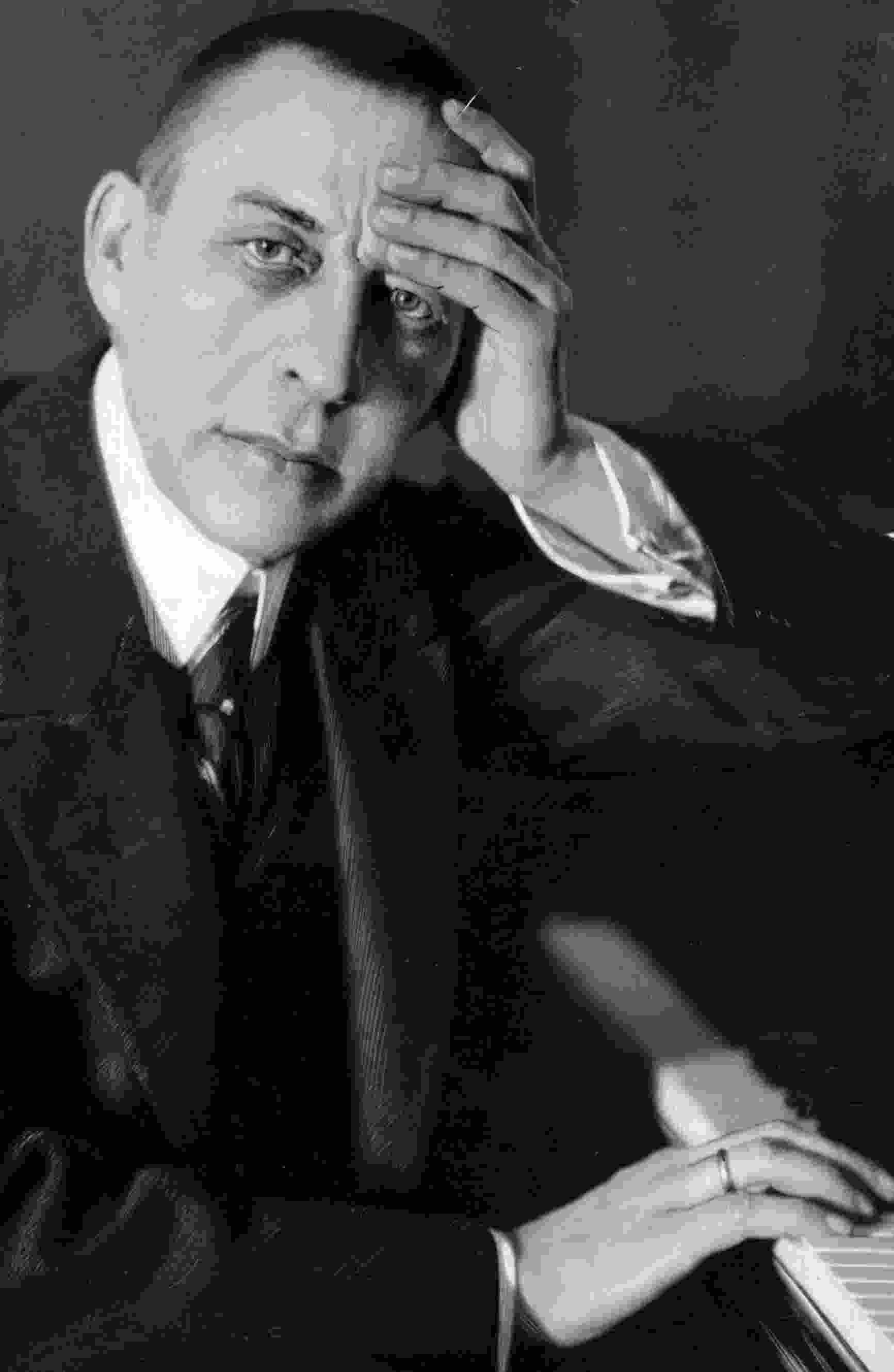 In
complete contrast was the following and final part of the evening’s
program which featured Sergeï Rachmaninov (1873-1943). I
can’t begin to describe the great depth of emotion that
filled Bourgie Hall. The Elegiac Piano Trio No.2 for Piano and
Strings in D Minor, Opus 9 obviously moved us all. We were silent
for several seconds after the final No. 3, Allegro risoluto -
Moderato movement that concluded the work. Then thunderous applause.
In
complete contrast was the following and final part of the evening’s
program which featured Sergeï Rachmaninov (1873-1943). I
can’t begin to describe the great depth of emotion that
filled Bourgie Hall. The Elegiac Piano Trio No.2 for Piano and
Strings in D Minor, Opus 9 obviously moved us all. We were silent
for several seconds after the final No. 3, Allegro risoluto -
Moderato movement that concluded the work. Then thunderous applause.
The opus
was written shortly after the death of Tchaikovsky. It featured
the uber- passionate expressive playing of violinist Yukari Cousineau
and cellist Vincent Bernard. But behind sometimes backing them,
but more often in the forefront, the piano was brought to life
by the virtuoso majesty of pianist Jean Saulnier. The work demanded
veteran accomplishment to loudly accent the octaves, master speed-defying
traveling up and down the keys that within a second suddenly asked
for thrillingly pianissimo trickle-like comb.
At times, deeply sad, awesomely angry, and finally resigned to
his friend’s death, Rachmaninov’s astounding composition
cried out for the very best musicians in technique, ensemble timing
and energetic expressiveness. The slow bowing, rapid fire rhythmic
harmonic combinations of striking, plucking, not to mention the
long ascensions of huge crescendos that often reached the instruments’
strings’ bridge, had us reeling with excitement and shock;
the range of emotion was staggering. Together, these three acclaimed
musicians entered the soul of Rachmaninov as if the composer were
speaking to us, revealing to the transfixed audience an absolute
torment that only music can express. His depth was heard and felt.
We left the concert feeling the world is in equal parts bright
and light -- as embodied in the Dvorák piece -- and also
dark and despairing.
An
Age-Mix of Musicians Performs Brahms Brilliantly
As part
of the youth and pros series, Arte Musica Foundation has paired
up the best of young Montreal musicians with their veteran counterparts
to perform in several chamber music concerts at Bourgie Hall.
On Wednesday, November 21st, the audience was treated to the remarkable
talents of these four already-acclaimed young musicians who have
trained at various Montreal music institutions. These outstanding
artists are: Baptiste Rodrigues (violin) and Amina Myriam Tébini
(viola) and Janelle Fung (piano). Save for Ms. Fung, each one
sat beside their corresponding mentor -- depending on the work
performed: Mark Fewer with Mr. Rodrigues and Douglas McNabney
with Ms. Tébini, and Matt Haimovitz with guest cellist
Philippe Muller from France performing in this exciting mix of
marvellous musicians.
Boldly
bridging the generation gap, the musicians proved performance
quality knows no age boundaries. Each stroke of string and strike
of piano key was a magnificent match of composer and performer.
Precision timing, breathtaking expressiveness, power, delicacy
and clarity could not have moved an inch more into the realm of
perfection. And to think these six musicians only had four days
to rehearse!
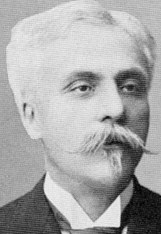 The
program opened with Gabriel Fauré’s Piano Quartet
No. 1 in C Minor, Op 15. Ms. Fung, who started piano at the age
of four, was supremely impressive with her ability to seemingly
have her fingers float over the keys; each note seemed to waft
into the air like a gentle breeze. Her romantic touch is akin
to Arthur Rubinstein’s sound. The strings seemed to emulate
water rippling ever so gently with the wind above -- undulating
little waves below. All four musicians teamed up as one force.
This piece was so smooth and graceful. Segments of swelling grandeur
and sweet tranquility created enchanting contrasts in this work
of four movements. Fung was so relaxed, yet when time came to
attack in formidable crescendo fashion, she did -- with the others
bolstering it all. The Scherzo of this work was playful and cocky
-- a surprising contrast to the other three movements whose rhythms
were imbedded in mature expressiveness.
The
program opened with Gabriel Fauré’s Piano Quartet
No. 1 in C Minor, Op 15. Ms. Fung, who started piano at the age
of four, was supremely impressive with her ability to seemingly
have her fingers float over the keys; each note seemed to waft
into the air like a gentle breeze. Her romantic touch is akin
to Arthur Rubinstein’s sound. The strings seemed to emulate
water rippling ever so gently with the wind above -- undulating
little waves below. All four musicians teamed up as one force.
This piece was so smooth and graceful. Segments of swelling grandeur
and sweet tranquility created enchanting contrasts in this work
of four movements. Fung was so relaxed, yet when time came to
attack in formidable crescendo fashion, she did -- with the others
bolstering it all. The Scherzo of this work was playful and cocky
-- a surprising contrast to the other three movements whose rhythms
were imbedded in mature expressiveness.
The
program continued with two other works by Brahms who is one of
my favourite composers to play because of the soulful wisdom and
emotional depth conveyed both by melody and dramatic  syncopation.
Each movement both in the Piano Quartet No. 2 in A Major and in
the B-Flat Major were executed with restrained passion and understanding.
One was treated to the broad-spectrum of Brahms compositional
flavours: the magisterial, the melancholic, the unbearably heart-breaking,
the sweet, the surly and the dashing. The cello long bowing was
powerful in the Andante of the B-flat major; its melodic line
was reminiscent of Prokofiev’s Romeo and Juliet. What a
team of terrific artists!
syncopation.
Each movement both in the Piano Quartet No. 2 in A Major and in
the B-Flat Major were executed with restrained passion and understanding.
One was treated to the broad-spectrum of Brahms compositional
flavours: the magisterial, the melancholic, the unbearably heart-breaking,
the sweet, the surly and the dashing. The cello long bowing was
powerful in the Andante of the B-flat major; its melodic line
was reminiscent of Prokofiev’s Romeo and Juliet. What a
team of terrific artists!
The
emotional range exhibited by these performers whose ability to
pull off finales that seemed to be faster than the speed of sound
left us gasping out of disbelief. The Allegro, alla breve in the
A Major Piano Quartet was a fine example of that alacrity and
instrumental vigour. Such exhilaration.
The
biography of each of these featured artists who have already received
rave reviews internationally is the envy of most emerging musicians.
They have already earned world-wide fame.
As far
as I am concerned, the veteran pro paired during this concert
to his younger ‘version’ was one and the same. Everyone
was a pro. Bravo.
Kudos
to the prescience of the president of the Foundation, Pierre Bourgie
and Isolde Lagacé, General and Artistic Director for bringing
together the young and the older to make music in ways that everyone
learns and comes out feeling they have all been drinking from
the fountain of youth. I certainly felt invigorated after such
a thrilling performance.
Thank
you Musica Arte Foundation.
Kimy
McLaren Delivers Many Moods in Debussy Program
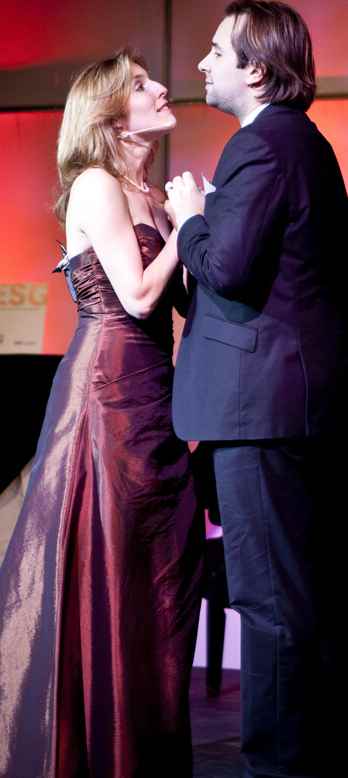 A
prize-winner at the international Mozart Competition in Salzburg
in 2002, Ms. McLaren began garnering acclaim early on in her opera
singing career. This soprano also walked away with top honours
at the Mario Lanza Opera Competition in Italy one year later,
and the following year, was admitted into the coveted Jeune Voix
du Rhin training program in Strasbourg. She has performed in several
opera halls in Europe, especially in France.
A
prize-winner at the international Mozart Competition in Salzburg
in 2002, Ms. McLaren began garnering acclaim early on in her opera
singing career. This soprano also walked away with top honours
at the Mario Lanza Opera Competition in Italy one year later,
and the following year, was admitted into the coveted Jeune Voix
du Rhin training program in Strasbourg. She has performed in several
opera halls in Europe, especially in France.
Her sensitivity
to French lyric -- its romanticism and mercurial moods was most
obvious during the all-Debussy program performed inside the lovely
Bourgie Hall during the afternoon of October 28th.
Despite
having a cold -- she used a handkerchief which was discreetly
resting inside piano under its lid -- Ms. McLaren mastered the
lengthy program with only or two sniffles. What a pro! The 18
songs did not suffer from this, which speaks to her professionalism
and uncanny ability to produce and rise above the obstruction
that most certainly affects the voice.
The first
two songs (“La Mer est Plus Belle,” and “Beau
Soir“) offered impressionist poetry both dark and uplifting,
and although Ms. McLaren did not quite capture the nuances, as
her upper register was a tad overpowering in some parts, I put
this down to opening jitters and the cold. However, the following
collection of lovely songs, such as “On the Strand“,“Flowers,
Evening “ and “Muted“ were artfully graceful
and offered vocal tones and variety that aptly suited the lyric
and melody. Moods of sadness, reflection, joy and ominous tidings
were stunningly conveyed by Ms McLaren. What’s more, she
showed off her playful manner in the song, “Puppets. “
It was capricious and most entertaining.
Poetry
by Debussy, Verlaine, Pierre Louys and Paul Bourget just made
it all so beautiful, and the fact the poems were translated into
English proved satisfying to all who attended.
Accompanying the star singer was Patil Harboyan. Debussy’s
spirit flowed from her fingers. Rippling effects and soft nuances
to Ms. McLaren’s singing were sublime. 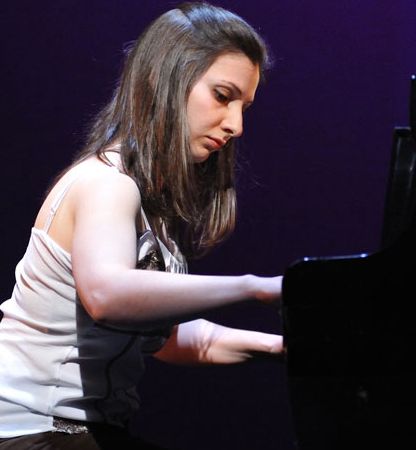 She
is a consummate pianist who stands out whether playing chamber
music, or solo piano. Sought after all over North America, she
has performed at the Weill Recital Hall at Carnegie Hall, and
has recorded in a collaborative project in London, England. Indeed,
Ms. Harboyan is a divine gift to listen to.
She
is a consummate pianist who stands out whether playing chamber
music, or solo piano. Sought after all over North America, she
has performed at the Weill Recital Hall at Carnegie Hall, and
has recorded in a collaborative project in London, England. Indeed,
Ms. Harboyan is a divine gift to listen to.
Another
afternoon surprise that one is rarely privy to -- because he is
so busy performing all over Quebec -- was the appearance of the
incomparable clarinettist, Jean-Francois Normand. His mastery
of tone during any sustenuto -- whether melodically soft or during
an increasing ascension to a crescendo -- defied usual clarinet
expressiveness. The piece, titled, “Première Rhapsodie
pour Clarinette et Piano“ was Debussy at his finest. It
was so richly interpreted. Neither ornamentation nor quality of
intonation was sacrificed for the sake of speed. In fact, each
note resonated like a songbird singing especially for you.
The entire
concert was indeed rather special.
Beautiful
Concerts Echo the World in Bourgie Hall
The
Foundation Arte Musica is presenting a series of outstanding
concerts within the magnificent Bourgie Hall. The collaboration
of it founder, Pierre Bourgie, and the general and artistic
director of the Arte Foundation, Isolde Lagacé, has created
a remarkable gift of music, art, film and lectures to inspire
all lovers of beauty. In fact, the program reflects the various
exhibitions housed in the Museum itself. From Debussy and French
music to Latin America with a focus on Peru and Brazil, the
music creates a glorious echo of the visual side of art that
is on display at the museum.
I had
the pleasure to attend some of these concerts – the first
of which featured musicians from the Orchestre Métropolitain:
violinists Yukari Cousineau and Marcelle Mallette, violists Brian
Bacon and Pierre Tourville, cellist Vincent Bernard and pianist
Jean Saulnier.
 The
first part of the program featured a wondrous work by Antonin
Dvorák (1841-1904): the String Quintet in E-flat Major,
Opus 97, B. 190. Its four movements evoked vivid images of forest
magic. I felt as if I were walking in a nature nook where the
wind was whispering among leaves over my head and an enchanting
babbling brook was at my feet. The masterful variations of string
bowing created these images within a melody mimicking the airy
beauty of fluttering winged birds darting in and out of trees.
The gentle musical line ripe with rises and falls from the violas
seemed to replicate rippling waters. Great timing and mature energy
infused the playing.
The
first part of the program featured a wondrous work by Antonin
Dvorák (1841-1904): the String Quintet in E-flat Major,
Opus 97, B. 190. Its four movements evoked vivid images of forest
magic. I felt as if I were walking in a nature nook where the
wind was whispering among leaves over my head and an enchanting
babbling brook was at my feet. The masterful variations of string
bowing created these images within a melody mimicking the airy
beauty of fluttering winged birds darting in and out of trees.
The gentle musical line ripe with rises and falls from the violas
seemed to replicate rippling waters. Great timing and mature energy
infused the playing.
Indeed
such highly expressive renderings showcased the impeccable ensemble
playing of these five musicians. The third movement’s Larghetto
seemed to take a pensive turn into nostalgia and sadness. It was
as if this person I had imagined was actually reminiscing about
the days gone by when he or she could enjoy all this freedom in
nature. Was this the secret spot for a now older person who was
reflecting back on childhood? Clearly Dvorák was inspired
by his land. This was not music made to impress aristocrats; this
was music for people living in and in love with the rustic surroundings
characterizing their country’s countryside. There were suggestions
of peasant robustness -- I could hear that Czech flavour echoing
in various parts.
Immaculately
played with magnificent nuances, the musicians’ ensemble
performance was remarkable. The music turned Bourgie Hall into
a glorious forest glen of inestimable beauty. Lucky for me, I
was in the midst of such lush verdant paradise not lost but found!
 In
complete contrast was the following and final part of the evening’s
program which featured Sergeï Rachmaninov (1873-1943). I
can’t begin to describe the great depth of emotion that
filled Bourgie Hall. The Elegiac Piano Trio No.2 for Piano and
Strings in D Minor, Opus 9 obviously moved us all. We were silent
for several seconds after the final No. 3, Allegro risoluto -
Moderato movement that concluded the work. Then thunderous applause.
In
complete contrast was the following and final part of the evening’s
program which featured Sergeï Rachmaninov (1873-1943). I
can’t begin to describe the great depth of emotion that
filled Bourgie Hall. The Elegiac Piano Trio No.2 for Piano and
Strings in D Minor, Opus 9 obviously moved us all. We were silent
for several seconds after the final No. 3, Allegro risoluto -
Moderato movement that concluded the work. Then thunderous applause.
The opus
was written shortly after the death of Tchaikovsky. It featured
the uber- passionate expressive playing of violinist Yukari Cousineau
and cellist Vincent Bernard. But behind sometimes backing them,
but more often in the forefront, the piano was brought to life
by the virtuoso majesty of pianist Jean Saulnier. The work demanded
veteran accomplishment to loudly accent the octaves, master speed-defying
traveling up and down the keys that within a second suddenly asked
for thrillingly pianissimo trickle-like comb.
At times, deeply sad, awesomely angry, and finally resigned to
his friend’s death, Rachmaninov’s astounding composition
cried out for the very best musicians in technique, ensemble timing
and energetic expressiveness. The slow bowing, rapid fire rhythmic
harmonic combinations of striking, plucking, not to mention the
long ascensions of huge crescendos that often reached the instruments’
strings’ bridge, had us reeling with excitement and shock;
the range of emotion was staggering. Together, these three acclaimed
musicians entered the soul of Rachmaninov as if the composer were
speaking to us, revealing to the transfixed audience an absolute
torment that only music can express. His depth was heard and felt.
We left the concert feeling the world is in equal parts bright
and light -- as embodied in the Dvorák piece -- and also
dark and despairing.
For information
on upcoming concerts and tickets, visit: www.bourgiehall.ca.
You can also call (514) 285-2000.
* * * * * * * * * *
Jean-Philippe
Collard Brings Claude Debussy Back To Us
A
Concert Marking the 150th Anniversary of the Composer's Birth
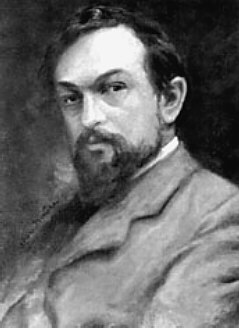
Mist,
mystery and visions of the sea sublime filled Bourgie Hall on
October 18th, as the great French pianist Jean-Philippe Collard
entranced us with his all-Debussy program. He performed 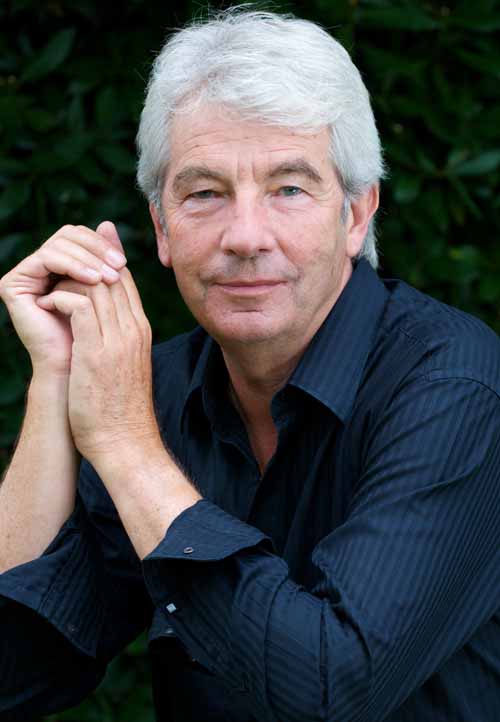 12
Preludes, the entire collection from Children's Corner,
Estampes (3 pieces) and L'Isle Joyeuse. His
boundless technique impeccably mastered the extraordinarily difficult
passages in such pieces as 'Les Collines de Anacapri' and 'La
Serenade interrompue' from the Preludes' segment. Percussive rapid
chords scaled the piano with fortissimo vigour; this is where
his affinity for Debussy left us breathless. Watery effects and
ominous shadows were created by his ability to move from powerful,
solid chording to repetitive triad-like key tickling and terrific
trilling.
12
Preludes, the entire collection from Children's Corner,
Estampes (3 pieces) and L'Isle Joyeuse. His
boundless technique impeccably mastered the extraordinarily difficult
passages in such pieces as 'Les Collines de Anacapri' and 'La
Serenade interrompue' from the Preludes' segment. Percussive rapid
chords scaled the piano with fortissimo vigour; this is where
his affinity for Debussy left us breathless. Watery effects and
ominous shadows were created by his ability to move from powerful,
solid chording to repetitive triad-like key tickling and terrific
trilling.
These
sounds particularly captivated us in such pieces as 'La Cathedrale
Engloutie' and 'Jardins sous la Pluie.' Impressionistic images
floated around the concert hall, bringing to mind the fact that
Debussy seemed to crystallize the musical language that preceded
him while creating new structural forms full of daring and sudden
expressive contrasts evocative of the twentieth-century. A genius
whose sensitivity found its voice in music, he lived during a
culturally rich period when painting, dance and literature merged
together and certainly affected him during his lifetime (1862
-1918). "I wanted from music a freedom which it possesses perhaps
to a greater degree than any other art, not being tied to a more
or less exact reproduction of nature but to the mysterious correspondences
between nature and imagination." Thus wrote Debussy.
Overall,
Mr. Collard successfully delved into Debussy's profound compositional
colouring. Albeit there were some uneven tempo points that were
somewhat exaggerated, along with periodic phrasal endings that
merited more attention -- more soft caressing, especially for
those gentle endings -- but Debussy is a composer where the lyrical
and the classical merge into an ambiguous playing field -- if
you will. Still, when Mr. Collard performed 'Voiles,' and again
as an encore, he clearly felt at one with the composer. His astounding
finale, 'L'Isle joyeuse,' surpassed excellence! What exuberance,
what control, what remarkable agility he possesses. His large
strong fingers were able to tread ever so daintily over the keys.
Mr Collard inspired me with his genius for blending speed with
softness in 'The Snow is Dancing.' He created an enchanting world
full of falling snowflakes that cocooned us all. I loved it.
Lyrical
nuance is key to Debussy. Clearly, Mr. Collard was intent on illustrating
this, but at times such expressiveness was not as big as it could
have been -- not as convincing as in those strong powerfully dominating
moments he ravishingly performed.
Mr. Collard's
lanky stature and noble Gaelic manner seemed to defy Debussy's
delicacy, yet this internationally acclaimed master of Debussy
possesses such a keen understanding of his intricacies. His playing
resonates his own personal thoughts recently published in a beautiful
little book entitled Elan Marins: Réflexions sur la
musique de Claude Debussy. This is a miniature literary gem
published under the editorship of Pierre Bourgie of Editions Arte
Musica -- the second one of its kind. Printed on wove paper with
a limited run of 300 -- of which forty are numbered and signed
by the author -- it also contains original etchings by Michael
Merrill. This new treasure is rare and enlightening as It beautifully
sheds light on composer and pianist in an intimate way.
For
information on upcoming concerts and tickets, visit: www.bourgiehall.ca.
You can also call (514) 285-2000.